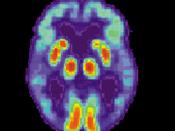Down's syndrome is a genetic condition involving an extra chromosome, this change occurs around the time of conception. A person with Down's syndrome has forty-seven chromosomes instead of the usual forty-six. A relatively common genetic disorder, Down's strikes 1 out of 600 babies. In 95 percent of all cases, the disorder originates with the egg, not the sperm, and the only known risk factor is advanced maternal age-at age 35, a woman has 1 chance in 117 of having a baby with Down's; at 40, her odds are 1 in 34.
(Graves, 1990)
People with Down's syndrome all have a certain degree of learning disability . This means that they develop and learn more slowly than other children. However, most children with Down's syndrome today will walk and talk, many will read and write, go to ordinary school, and look forward to a semi-independent adult life. (Platt and Carlson, 1992)
Facts on Down Syndrome
*Down syndrome is not a lethal anomaly.
One to two percent of persons born with this disorder have uncorrectable heart defects at birth. The average life expectancy for all others is now beyond age 55 years.
*Today less than 5% of persons with Down syndrome have severe-to-profound mental retardation. The majority are on the border of mild-to-moderate mental retardation, and some are exhibiting normal IQ scores today.
*The average reading level for persons with Down syndrome is 3rd grade, with many reading at 6th-12th grade levels today.
*The vast majority of adults with Down syndrome today can be expected to live semi- or totally independently and many enter the work force with today's supported employment programs and some are competitively employed.
Some medical conditions that demand special attention for people with Down syndrome include:
*Congenital Heart Disease: usually in the form of endocardial cushion defects, affects...


